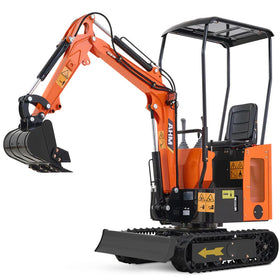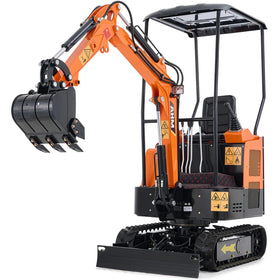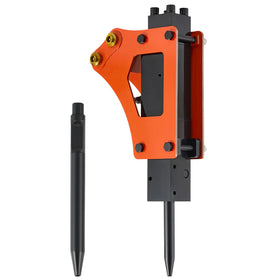Choosing the best mini excavator bucket isn't just about grabbing the biggest one that fits. It's about matching the right one to your specific job requirements, soil conditions, and machine capabilities.
Whether you're trenching utilities, grading landscapes, or handling demolition work, selecting the best mini excavator bucket can save you time, money, and numerous headaches.
The few minutes spent measuring can save hundreds in compatibility problems and equipment damage. The right bucket makes every job easier, faster, and more profitable.
Let's cut through the confusion and determine exactly which mini excavator bucket will ensure your projects run smoothly.

Factors to Consider When Choosing Mini Excavator Bucket Size
When selecting mini excavator bucket sizes, five critical factors determine which bucket delivers the best performance for your specific application:
- The size of your mini excavator
- The type or hardness of the soil you are working in.
- The nature of the project,
- The weight and balance of the bucket,
- The teeth configuration of the mini excavator bucket.
1. The Size of Your Mini Excavator
The size of your mini excavator bucket must match the size of your mini excavator. Bigger mini excavator buckets fit larger mini excavators, and vice versa. Here's the practical breakdown:
| Mini Excavator Size | Standard Bucket Width Range (in) | Grading Bucket Width (in) |
| Up to 0.75 ton | 6–24 inches | 30 inches |
| 1–1.9 ton | 6–24 inches | 36–39 inches |
| 2–3.5 ton | 9–30 inches | 48 inches |
| 4 ton | 12–36 inches | 60 inches |
| 5–6 ton | 12–36 inches | 60 inches |
Use this mini excavator size chart to determine the size mini excavator you need.
2. Soil Conditions
There are various types of mini excavator buckets, each designed to work effectively on different types of soil. As a rule, the harder the soil, the smaller you want your mini excavator bucket to be.
Here are some guidelines on choosing a mini excavator bucket for different kinds of soil:
| Ground Type | Recommended Bucket Width (inches) |
| Normal Dirt/Soil | 24 |
| Rock-Filled/Compacted | 18–20 (smaller than standard) |
| Soft Dirt or Sand | 30–36 (larger than standard) |
You may also need these tips on digging in hard soil with a mini excavator
3. Consider Application-Specific Requirements
There are numerous projects you can undertake with a mini excavator. However, the success you achieve on each of those projects will depend mainly on choosing a suitable bucket.
- Trenching: Match bucket width to trench requirements. A 12-inch water line needs a 12-inch or narrower trenching bucket.
- Material handling: Larger buckets move more material per cycle, but consider the weight - heavier loads reduce cycle speed and increase fuel consumption.
- Precision work: Utility installations around existing pipes require smaller, more precise buckets to avoid damage.
Explore this mini excavator digging guide for some amazing projects you can do with a mini excavator.
4. Weight and Balance
Mini excavator weight matters, especially when deciding on which mini excavator bucket to get.
- Standard digging buckets weigh between 100 and 500 lbs, depending on their size.
- Larger buckets reduce lifting capacity and affect machine stability.
Always stay within the manufacturer's weight recommendations to prevent tipping and maintain productivity.
4. Mini Excavator Bucket Teeth Configuration
Choosing and maintaining mini excavator bucket teeth requires careful consideration. Here’s a summary:
- General-purpose buckets: Feature 3-9 short, blunt teeth for versatile digging in soil and light materials.
- Rock buckets: Include sharp, reinforced teeth designed for breaking through tough materials and frozen ground.
- Grading buckets: Use smooth cutting edges without teeth for finishing and leveling work.

Are All Mini Excavator Buckets Interchangeable?
Mini excavator buckets are definitely not universal or interchangeable. Each bucket requires specific pin dimensions that must match your excavator exactly.
Critical Pin Measurements
To determine bucket compatibility, you need three precise measurements:
- Pin Diameter: Measure the width of the pins - common sizes include 25mm (0.98"), 35mm, 40mm, and 65mm for different excavator classes.
- Pin Centers: Distance between pin centers, measured from the center of one pin to the center of the other. This affects bucket rotation and breakout force.
- Dipper Gap: Internal width between bucket hangers where your excavator arm fits. Measure the smallest internal dimension between the bosses.
Why Compatibility Matters when it Comes to Mini Excavator Buckets
Using incompatible buckets creates serious problems:
- Safety risks: Improper fit can cause bucket detachment during operation
- Performance issues: Wrong pin spacing affects digging geometry and reduces efficiency
- Equipment damage: Forcing incompatible attachments can damage expensive hydraulic systems

Best Mini Excavator Buckets for Professional Applications
When you need the best mini excavator bucket performance, choosing quality attachments designed for your specific applications makes all the difference.
1. AHM 200mm Narrow Trenching Bucket
Starting at $289.99, the AHM 8-inch narrow bucket delivers exceptional value for precision trenching. This trenching bucket for mini excavator work features a 200mm (7.9-inch) width, which makes it perfect for utility lines, drainage systems, and pipeline excavation in tight spaces.
- The high-hardness manganese steel construction provides exceptional durability and wear resistance.
- The 37.3-pound weight maintains excellent balance on excavators up to 2 tons.
It includes hinge pins and hydraulic hoses to ensure quick, hassle-free installation, minimizing downtime and making it perfect for contractors who need reliable, precise trenching capability.
2. AHM 300mm Narrow Trenching Bucket
Starting at $279.99, the AHM 12-inch narrow bucket provides the ideal balance between trenching precision and material handling capacity.
This mini excavator grading bucket is ideal for medium-width trenches, foundation work, and landscaping applications that require more capacity than the 8-inch model.
The 300mm (11.8-inch) width handles larger utility installations while maintaining the precision control needed for working around existing infrastructure. At 44.3 pounds, it offers increased material capacity without compromising machine stability, making it the go-to choice for diverse trenching and excavation projects.
3. AHM Quick Hitch Attachment System
Starting at $239.99, the AHM quick hitch revolutionizes bucket changing efficiency by allowing swift attachment changes without time-consuming pin removal.
This system works with all AHM bucket types and many other compatible attachments, dramatically reducing changeover time from minutes to seconds.
The high-quality manganese steel construction handles heavy-duty applications while the standardized pin configuration ensures reliable, secure connections.
For contractors using multiple bucket types throughout the day, this quick hitch system pays for itself quickly through increased productivity and reduced labor costs.
All AHM buckets feature the same high-quality manganese steel construction, standardized pin dimensions for universal compatibility with AHM excavators, and include necessary hardware for immediate installation.

Conclusion
Choosing the best mini excavator bucket comes down to understanding your specific needs and matching them with the right attachment specifications and quality.
Start with your excavator size. Use the size charts above to determine compatible bucket widths for your machine weight class. Consider your most common applications.
If 70% of your work involves trenching, invest in quality trenching buckets for mini excavator applications. For diverse projects, consider a quick hitch system with multiple bucket types.
Stop guessing about bucket compatibility and performance. Match your mini excavator bucket to your actual job requirements, invest in quality attachments that last, and discover how much more efficient your projects become with the right tools for the job.







